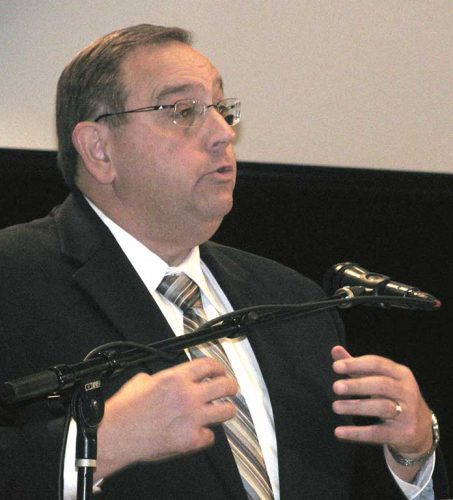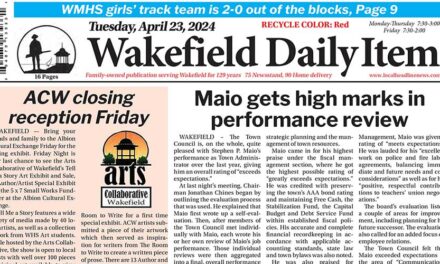Published in the January 3, 2019 edition
By MARK SARDELLA
 WAKEFIELD — When Rick Stinson walks out the door of Town Hall on June 28 for the last time after 18 years as Director of Public Works, it will be as the second longest-serving DPW Director in the town’s history. Only Stinson’s mentor, Dick Boutiette, held the position longer, serving for 31 years.
WAKEFIELD — When Rick Stinson walks out the door of Town Hall on June 28 for the last time after 18 years as Director of Public Works, it will be as the second longest-serving DPW Director in the town’s history. Only Stinson’s mentor, Dick Boutiette, held the position longer, serving for 31 years.
Stinson will retire at the end of June 2019 after 40 years of public service, 33 of those in Wakefield, the town he grew up in.
After graduating from Wakefield Memorial High School in 1977, Stinson earned a bachelor’s degree in Business Administration at the University of Massachusetts, Amherst. In 1991, he received a Certificate of Special Studies in Administration and Management from Harvard University.
His employment with the town started while he was still in high school as summer help with the Light Department. After college, MGLD General Manager Bill Wallace asked Stinson to stay on as an analyst, focusing on IT and engineering.
In 1988, Boutiette asked him to come over to the DPW as Business Manager, a position he held until 1994 when he left to take the position of Operations Director for the Danvers DPW.
But by 2001 Stinson was back in Wakefield to stay as Director of Public Works, managing the second largest town department with 77 employees across 11 divisions and an annual budget of over $20 million.
Stinson said that he has modeled his management style after that of Dick Boutiette, who would give direction but then allow his supervisors and workers an opportunity to grow by bringing their own creativity to the job. Stinson said that after Boutiette retired they would still go out to lunch at least once a month.
“I missed him when he passed away in 2012,” Stinson says.
One of Stinson’s most gratifying accomplishments as DPW chief involved holding the Public Works Department together during the difficult financial times of the 2000’s.
“Working together, we were able maintain the community’s infrastructure with limited resources and staffing,” Stinson says. “It’s easy to accomplish things when you have sufficient funding and staffing. It’s much more difficult when you do not have the proper funding and staffing. The job the DPW did during the 2000’s with limited staffing and funding was monumental and extremely satisfying.”
He’s also proud of his department’s ability to take on more responsibilities with less staff. He notes that during the 1980s there were over 90 DPW employees. The current staff of 77 has taken on the added responsibility for maintaining the town’s school buildings (including, a larger middle school and two larger elementary schools), a substantially larger Public Safety Building, a Senior Center and new parks and fields. The DPW also maintains most of the town’s vehicles, with the exception of fire engines and school buses.
“The staff has been terrific,” he says. “They have been the backbone of Public Works.” He credits the DPW staff with a lot of the successes during his tenure. “It takes a lot of support and dedication,” he adds. “They have been tremendous.”
Stinson also points with pride to the rebuilding of the high school athletic facilities (Landrigan Field, Shaun F. Beasley Track & Field, Dobbins Tennis Courts and the WMHS Field House). He remembers being in 8th grade and watching as the addition was being put on the junior high school on Farm Street in order to turn it into the high school.
“It was extremely satisfying to rebuild these facilities to the highest of standards,” Stinson says, “facilities that I and many other staff members used when attending Wakefield High School in the 1970’s. It was a great joy to do that because you’re rebuilding something you used as a kid.”
He is also proud of the role he’s played in rebuilding the town’s infrastructure, including key components of the water and sewer systems.
“The number of projects over the past 18 years are too many to count,” Stinson says, “but it is satisfying to know that we had an impact on the future of the town — rebuilding the town’s infrastructure so that the future is better for those who follow us.”
Another point of pride for Stinson was the implementation of automated refuse collection and single-stream recycling. Those programs have reduced rubbish tonnage by 40 percent and increased recycling by 15-20 percent, saving the town a lot of money.
Stinson also points to what has been accomplished with the town’s roads, although he acknowledges that due to funding shortages the town is still way behind on repaving.
“We can’t do as much as we want,” in terms of repaving streets, he says. “But we’ve done a lot.”
The expansion of Forest Glade Cemetery and digitizing of cemetery records were also done during his tenure as DPW Director.
One thing Stinson has really enjoyed is working with the town’s volunteer groups like the Wakefield Center Neighborhood Association, the Friends of Lake Quannapowitt, the Rotary Club, the Main Street Program and others on projects to benefit the town. Thanks to the assistance of these volunteer groups, the town has been able to install over 125 benches, upgrade the railings along Veterans Memorial Common as well as many other projects.
The DPW also assisted the World War II Memorial Committee with construction management, bidding and specs for the new monument, Stinson noted. Six or seven playgrounds have also been upgraded with volunteers providing funding and/or labor, including Moulton Playground and J.J. Round.
“A lot of towns don’t have the volunteer groups that we have,” Stinson observes. “I can’t thank them enough for all they do for the town.”
One thing that makes public works so gratifying, Stinson says, is the fact that everyone benefits from the services provided. Everyone uses the roads, the sidewalks, the parks and the water and sewer systems.
“We impact everyone in town,” Stinson says. “I will miss working with a lot of people in town.”
Stinson says that people sometimes find it odd when he says that he loves handling emergencies. But the reason is that he enjoys the challenge.
“You want to make sure everyone is safe, no one gets hurt and you want to get things back to normal as quickly as possible.” Stinson says that he doesn’t view emergencies at a headache but as an opportunity to do what’s best for the community.
He says that his goal has always been to be a strong caretaker of the community’s investment and infrastructure, and that means seeing that the town’s money is spent efficiently and economically.
During his career, Stinson has earned the respect his peers around the country and has been the recipient of some prestigious awards.
In 2003, the American Public Works Association (APWA) named him as one of the Top Ten Public Works Leaders of the Year (the APWA includes US and Canada). He was named an APWA Public Works Leadership Fellow in 2011, the same year that he received the New England Chapter of APWA Distinguished Service Award.
In 2010, Stinson received the Essex County Highway Association’s Newton “Newt” Sweet Award, “for outstanding and innovative achievement in Public Works.”
Stinson is especially proud that he was one of a very select group chosen to serve on the national Board of Directors of the 30,000-member APWA. “I couldn’t have done it without the support of the staff and the town,” he said.
In 2013, he was inducted into the Wakefield Memorial High School Alumni Hall of Fame.
Stinson sees three major challenges facing the DPW in the future. One relates to addressing the aging Public Works facility on North Avenue, which was built in 1932 and hasn’t seen any investment since 1972.
Roadways will remain an ongoing issue as long as funding continues to lag behind, Stinson says. Between the state and the town only about 40 percent of needed roadwork is currently being funded each year.
Storm water management is going to be a huge cost to the town going forward, Stinson notes, primarily due to increasing costs associated with the federally mandated National Pollutant Discharge Elimination System (NPDES).
Other projects on the horizon include the major overhaul of the infrastructure along the Main Street corridor, the Wakefield-Lynnfield Rail Trail project and the National Grid underground transmission line.
Stinson says the he will be leaving behind a top-notch administrative staff and an excellent corps of DPW workers. He’s grateful for the support he’s gotten over the years.
“Other town department heads and boards have been tremendous to work with,” he says, adding that the way they support each other in Wakefield is something that doesn’t always happen in other communities.
Stinson also recognizes the support of his family.
“I am extremely grateful for the support of my family and especially my wife Jeanne,” Stinson says. “Public Works is a 24/7/365-day-a year job. There are numerous emergencies, events, night meetings and many other tasks that require you to be away from home. The support of your family is critical to serving the town and its residents.”
As for his own future plans, Stinson says that he and his wife will do some traveling. He also says that he’ll be looking for some kind of part-time work, possibly some consulting.
“I can’t stay not busy,” he says, adding that he wants to remain somewhat involved in the public works arena.
“I’ve really enjoyed working in Wakefield because I love the community,” he says. “I’ll still be around. I’ll still be in Wakefield. I don’t want to leave a place that I really love.
“The other thing I love is public works,” Stinson adds. “I love what I do, so it’s hard to leave.”




